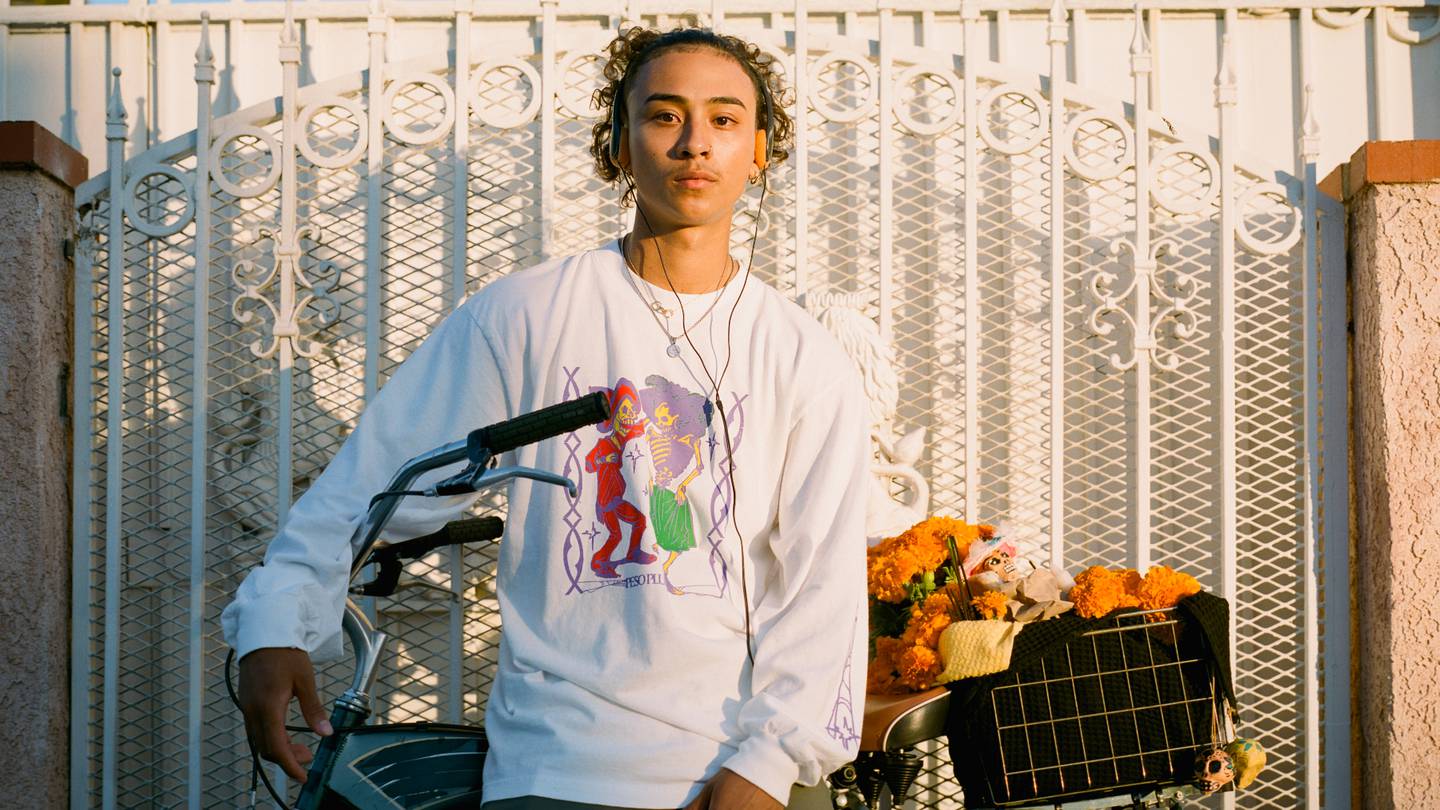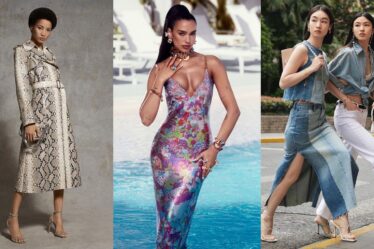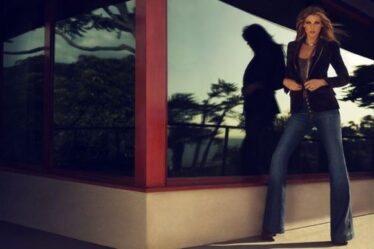
Indrė Narbutaitė and Lukas Žvikas, founders of UK-based streetwear brand Broken Planet, can vividly recall how as students in 2018, they queued for hours before Travis Scott’s Astroworld concert in London to buy T-shirts from the tour — wardrobe grails they treasure to this day.
It was a full-circle moment, then, earlier this year, when the duo was asked to design a merch capsule for hip-hop festival Rolling Loud in Portugal, which featured Travis Scott, among others, as a headliner. The collection comprised of T-shirts and drop-shoulder hoodies featuring colourful graphics relating to three of the festival’s biggest acts: Scott, Playboy Carti and Meek Mill.
Known for oversized streetwear silhouettes with large, playful text, Broken Planet hypes its products through behind-the-scenes TikToks and boisterous pop-up events. The brand’s founders used the same formula with its Rolling Loud merch.
Each day when the festival’s doors opened at 4 p.m., Narbutaitė and Žvikas were taken aback as people sprinted over to get their hands on the merch, which would sell out within 20 minutes, Narbutaitė said.
The author has shared an Instagram Post.You will need to accept and consent to the use of cookies and similar technologies by our third-party partners (including: YouTube, Instagram or Twitter), in order to view embedded content in this article and others you may visit in future.
In collaborating with Broken Planet, Rolling Loud benefitted from the brand’s clout among hip-hop fanatics and a scarcity model. To this day, the Broken Planet x Rolling Loud hoodies change hands on resale sites for as much as €340 ($370), more than double the original retail price of €140.
Broken Planet’s collection was a far cry from how music merch is typically created, where artists print graphics on cheap T-shirts that end up being forgotten or used as pyjamas. Today, artists and festival organisers are levelling up their merch by tapping legitimate names in fashion and streetwear, to not only transform their merch into valuable fashion pieces but also to be able to charge more for each shirt or jumpsuit. The market is certainly there; vintage and limited-edition band T-shirt can go upwards of hundreds of dollars for a single piece at specialty shops today.
“Music merch is this perfect opportunity to have your brand remembered for creating clothing which people have an emotional connection to, forever,” said Narbutaitė.
“It’s the ultimate symbol of belonging. This is why people go crazy for it, to be able to say: ‘I was there,’” added Žvikas.
For artists, the upside is high: If successful, merch can provide a lucrative revenue source that supplements their income from touring — a necessity considering the notoriously low rates musicians receive from streaming platforms. Rather than striking deals with licensing companies that take sole responsibility for creating the merch, top artists today are taking their merch production in-house, where they have a say over the look, feel and distribution of the product, and take a greater share of the revenues.
Travis Scott’s ongoing “Utopia” tour, for example, saw merch sales surpass $1 million per night at shows in Dallas and Denver, smashing record sales for both venues, according to Complex.
“Artists are increasingly beginning to understand the real value in owning the process of creating their merch, rather than going for standard licensing deals,” said Tersha Willis, chief executive of Terrible, a London-based start-up working with rising British artists like Sampha and TikTok-favourite singer Pink Pantheress to create and sell dedicated merch to mark album launches, tour dates and retail pop-ups.
Fashion Leans into Music
Broken Planet is hardly the only buzzy brand tapped to make merch. Last month, Balenciaga announced a partnership to create a “tech-enabled merch series” on behalf of Archive, a London-based trip-hop group. And earlier in November, British luxury designer Martine Rose designed merch including T-shirts and a scarf for “The Hillbillies,” a single released by Kendrick Lamar and Baby Keem. The collection, which included a reworked version of the brand’s signature V-neck football jersey, sold out instantly both in-person at LA’s Camp Flog Gnaw festival and on the Martine Rose e-commerce site.
In recent years, luxury brands have increasingly looked to the music industry to boost their appeal to consumers and reach new demographics. In February, Pharrell Williams was appointed Louis Vuitton’s menswear chief; Lanvin tapped American rapper Future to design a unisex capsule collection for the brand which was released earlier this month; and Dior collaborated with Travis Scott’s Cactus Jack label last year.
Sportswear brands have also got in on the act. Drake’s “Nocta” collaboration with Nike has become one of the brand’s most coveted sub-labels in the streetwear community, while Puma announced the comeback of its Fenty x Puma line with Rihanna earlier this year, and hired A$AP Rocky as creative director of its Formula 1 partnership to create a high-end range of motorsports-inspired merch.
The Fashion Transformation of Merch
The pivotal point for the intersection of fashion and music merch can be traced to the mid- to late-2010s, and was best demonstrated by Travis Scott’s 2018 Astroworld tour, according to publicist and music industry expert Eki Igbinoba.
“The Astroworld tour played a huge part in shifting people’s perception and expectation of what tour merch should look like,” she said. “It looked more like a Supreme drop, these were products from a credible streetwear brand than the usual printed T-shirts with an artist’s name and tour dates.”
Scott designed much of the clothing himself, as well as collaborating with several partners, from Virgil Abloh to the NBA’s New York Knicks, to drive hype around location-specific exclusive merch for various tour.
The rest of the industry has taken note. It’s now common for record labels, artists and festivals to tap streetwear specialists like Broken Planet to design merch as they would a traditional collection. Artists like Tyler, the Creator have built entire brands out of their merch. The American rapper and producer’s Golf Wang label has flagship stores in LA, New York and London.
“Since the pandemic, we have seen a massive acceleration in mainstream artists and record labels investing in more fashionable, better-looking tour merch offerings, sold online all year round, beyond just tour dates,” said Igbinoba.
Willis of merch agency Terrible said her business has received an influx of interest among artists as the industry emerged from the pandemic and artists were able to resume touring, looking to take a more strategic approach to merch.
The Future of Merch
Even without the halo effect of fashion, merch is a booming business, and the music industry’s biggest players are muscling in. Last year, Sony took a stake in California-based merch maker Ceremony of Roses and made it its in-house merch production arm.
Spotify has leveraged its jersey sponsorship deal with historic Spanish football club FC Barcelona since the 2022-23 season, creating one-off jerseys worn by the team during games featuring the logo of Drake’s OVO record label, the “Motomami” album artwork of Spanish singer Rosalia, and most recently the Rolling Stones iconic tongue-and-lips symbol. This unique three-way tie-up was so popular that they inspired dupes sold on the internet. It also opened Spotify’s eyes to the potential of merch as a significant future revenue stream, said the company’s vice president, head of music, Jeremy Elrich.

In November, the streaming platform announced a “Capsule Collection” project, which features weekly drops of limited-edition merch from the likes of Peso Pluma, Daft Punk, Tyler the Creator, Tems, and Rosalía.
“Merch is one of the biggest product categories that artists can generate sales from, along with live appearances and publishing recorded music,” said Elrich, who added that the company plans to expand the project to create a permanent platform where consumers can buy merch from various artists.
While online merch sales are a useful year-round source of income for artists and labels, for music fans, nothing can replicate the experience buying merch at live events — and this is where the biggest opportunities lie for brands and designers to convert new consumers.
“It’s this perfect retail moment that I don’t think is possible to replicate in any way,” said Willis. “A purely emotional connection of being in that place, at that time, with the artist and the people you share the moment with.”



